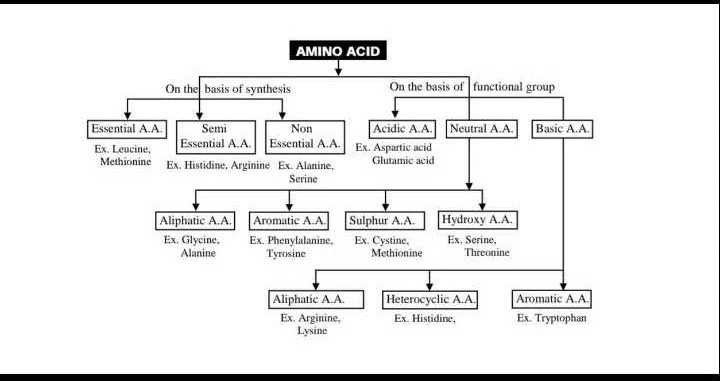NEET Exam > NEET Questions > Flow Chart of Amino Acid \\ its all about to ...
Start Learning for Free
Flow Chart of Amino Acid \\ its all about to help you so don't answer please?
Most Upvoted Answer
Flow Chart of Amino Acid \\ its all about to help you so don't answer ...
Amino Acid Flow Chart
Amino acids are the building blocks of proteins. They play a crucial role in maintaining the structure and function of the body's tissues and organs. There are 20 amino acids that are used to build proteins. They can be classified into two categories:
Essential amino acids
- Cannot be synthesized by the body
- Must be obtained from the diet
- Include histidine, isoleucine, leucine, lysine, methionine, phenylalanine, threonine, tryptophan, and valine
Non-essential amino acids
- Can be synthesized by the body
- Do not need to be obtained from the diet
- Include alanine, arginine, asparagine, aspartic acid, cysteine, glutamic acid, glutamine, glycine, proline, serine, and tyrosine
Amino Acid Structure
All amino acids have a similar structure, consisting of a central carbon atom, an amino group (NH2), a carboxyl group (COOH), and a side chain (R group) that varies between different amino acids. The side chain determines the unique properties of each amino acid.
Protein Synthesis
Proteins are synthesized through a process called translation, which occurs on ribosomes in the cytoplasm of cells. During translation, the genetic code in mRNA is read and translated into a sequence of amino acids. This sequence determines the structure and function of the protein.
Amino Acid Metabolism
Amino acids can be used for energy production, or they can be converted into other molecules such as glucose or fatty acids. The breakdown of amino acids produces ammonia, which is toxic to the body. The liver converts ammonia into urea, which is excreted in urine.
Amino Acid Deficiencies
A deficiency in one or more essential amino acids can lead to protein malnutrition, which can cause growth retardation, muscle wasting, and other health problems. Amino acid deficiencies can be prevented by consuming a balanced diet that includes all essential amino acids.
Community Answer
Flow Chart of Amino Acid \\ its all about to help you so don't answer ...

Attention NEET Students!
To make sure you are not studying endlessly, EduRev has designed NEET study material, with Structured Courses, Videos, & Test Series. Plus get personalized analysis, doubt solving and improvement plans to achieve a great score in NEET.

|
Explore Courses for NEET exam
|

|
Similar NEET Doubts
Flow Chart of Amino Acid \\ its all about to help you so don't answer please?
Question Description
Flow Chart of Amino Acid \\ its all about to help you so don't answer please? for NEET 2024 is part of NEET preparation. The Question and answers have been prepared according to the NEET exam syllabus. Information about Flow Chart of Amino Acid \\ its all about to help you so don't answer please? covers all topics & solutions for NEET 2024 Exam. Find important definitions, questions, meanings, examples, exercises and tests below for Flow Chart of Amino Acid \\ its all about to help you so don't answer please?.
Flow Chart of Amino Acid \\ its all about to help you so don't answer please? for NEET 2024 is part of NEET preparation. The Question and answers have been prepared according to the NEET exam syllabus. Information about Flow Chart of Amino Acid \\ its all about to help you so don't answer please? covers all topics & solutions for NEET 2024 Exam. Find important definitions, questions, meanings, examples, exercises and tests below for Flow Chart of Amino Acid \\ its all about to help you so don't answer please?.
Solutions for Flow Chart of Amino Acid \\ its all about to help you so don't answer please? in English & in Hindi are available as part of our courses for NEET.
Download more important topics, notes, lectures and mock test series for NEET Exam by signing up for free.
Here you can find the meaning of Flow Chart of Amino Acid \\ its all about to help you so don't answer please? defined & explained in the simplest way possible. Besides giving the explanation of
Flow Chart of Amino Acid \\ its all about to help you so don't answer please?, a detailed solution for Flow Chart of Amino Acid \\ its all about to help you so don't answer please? has been provided alongside types of Flow Chart of Amino Acid \\ its all about to help you so don't answer please? theory, EduRev gives you an
ample number of questions to practice Flow Chart of Amino Acid \\ its all about to help you so don't answer please? tests, examples and also practice NEET tests.

|
Explore Courses for NEET exam
|

|
Suggested Free Tests
Signup for Free!
Signup to see your scores go up within 7 days! Learn & Practice with 1000+ FREE Notes, Videos & Tests.

























